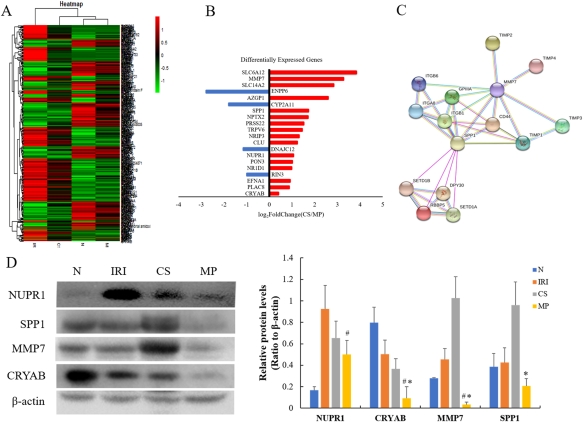Hypothermic Machine Perfusion Protects Rabbit Kidney Graft through Down Regulation SPP1-MMP7 Signaling Axis
1Zhongnan Hospital of Wuhan University, Transplant Center of Wuhan University, Hubei Key Laboratory of Medical Technology on Transplantation, Wuhan, China
2The 3rd Xiangya Hospital of Central Sourth University, Changsha, China.
Meeting: 2018 American Transplant Congress
Abstract number: D302
Keywords: Gene expression, Ischemia, Kidney transplantation, Machine preservation
Session Information
Session Name: Poster Session D: Late Breaking
Session Type: Poster Session
Date: Tuesday, June 5, 2018
Session Time: 6:00pm-7:00pm
 Presentation Time: 6:00pm-7:00pm
Presentation Time: 6:00pm-7:00pm
Location: Hall 4EF
Background: Multicenter studies have indicated that hypothermic machine perfusion(HMP) can be used to prolong cold ischemia time with high-quality preservation and allow utilization of kidney grafts . However, the mechanism underlying it is unclear.
Methods: In the previous research, a novel in vivo rabbit model for hypothermic machine perfusion had been established to simulate the clinical renal transplantation process. Based on this model, 12 rabbits were randomly divided into 4 groups: normal group(N), ischemia reperfusion injury group(IRI),static cold storage group(CS) and hypothermic machine perfusion group(MP). After hypothermic machine perfusion with 4h and static cold storage with 4h, differentially expressed genes of kidney tissues were detected by BGISEQ-500 RNA-Seq technique. Western blot was used to verify the differentiation genes corresponding proteins.
Results: BGISEQ-500-RNAseq data showed that 358 genes had been detected significant differences in these 4 groups. Then, we analyzed the most diverse top 20 genes and search them in the “STRING” database. Finally, western blot assay show that MMP7, SPP1 and CRYAB were up-expression(P<0.05) in CS groups and they have significant correlation between MMP7 and SPP1  .
.
Conclusion: we have confirmed that hypothermic machine perfusion protects rabbit kidney graft may through down regulation SPP1-MMP7 signaling axis, however, it need more evidence to prove whether SPP1 or MMP7 could be a newintervention target to protected kidney from ischemia reperfusion injury.
Figure legend: A, gene enrichment analysis were used to show the significant different expression of 358 genes. B, the notable diverse top 20 genes were selected. C, Correlations between the expression of SPP1 and MMP7 has been shown (download from “STRING”database). D,western blot was used to verified the differentiation genes corresponding proteins. (* denotes P < 0.05 compared to CS, #denotes P < 0.05 compared to N).
CITATION INFORMATION: Hu Q., Zhong Z., Xue S., Liang W., Lan J., Liang J., Xiong Y., Wang Y., Ye Q. Hypothermic Machine Perfusion Protects Rabbit Kidney Graft through Down Regulation SPP1-MMP7 Signaling Axis Am J Transplant. 2017;17 (suppl 3).
To cite this abstract in AMA style:
Hu Q, Zhong Z, Xue S, Liang W, Lan J, Liang J, Xiong Y, Wang Y, Ye Q. Hypothermic Machine Perfusion Protects Rabbit Kidney Graft through Down Regulation SPP1-MMP7 Signaling Axis [abstract]. https://atcmeetingabstracts.com/abstract/hypothermic-machine-perfusion-protects-rabbit-kidney-graft-through-down-regulation-spp1-mmp7-signaling-axis/. Accessed December 31, 2025.« Back to 2018 American Transplant Congress
